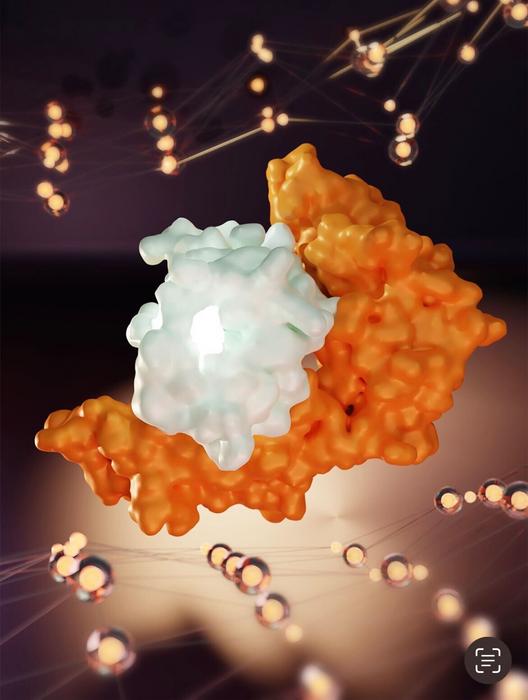Infection
Genetics explains why some individuals never have COVID-19 symptoms
image: The peptide NQK-Q8 (light color), a piece of SARS-CoV-2 spike protein that the virus uses to enter cells, bound to the HLA-B*15:01 groove (orange). The illustration is based on the crystal structure of HLA-B*15:01 in complex with spike derived peptide NQKLIANQF from SARS-CoV-2 virus (PDB Entry – 8ELH) published by Augusto et al., 2023 (Nature).
view more
Credit: André Luiz Lourenço
Have you ever wondered why some people never became sick from COVID-19? A study published today in Nature shows that common genetic variation among people is responsible for mediating SARS-CoV-2 asymptomatic infection. The results indicate that individuals having this variant never feel sick once infected. This exciting discovery was a result of a U.S.-Australia collaborative work led by Danillo Augusto, Ph.D., assistant professor at the University of North Carolina at Charlotte; Jill Hollenbach, Ph.D., professor at the University of California San Francisco; and Stephanie Gras, professor at La Trobe University in Australia.
The study focuses on a group of genes called human leukocyte antigens (HLA). These HLA genes code for proteins used by the immune system to identify your healthy cells and distinguish them from those infected by bacteria and viruses. The HLA system is critical for immune response and also highly variable among individuals. Because of the role of HLAs in fighting infection, the researchers wondered if there were specific variants that would make us more protected or susceptible to SARS-CoV-2 virus.
Hollenbach led the data collection, which started at the beginning of the pandemic. First, 29,947 unvaccinated individuals were screened using a mobile app designed specifically to track COVID-19 symptoms, and 1,428 reported a positive test for the virus. All individuals had their DNA previously sequenced to analyze their HLA genes. The researchers found that individuals having the genetic variant HLA-B*15:01 were much more likely to remain asymptomatic after infection. Impressively, this variant is present in about 10% of the population. In summary, individuals who had HLA-B*1501 in their genome could not dodge the infection, however they escaped being sick.
“We hypothesized that their immune system could react so fast and powerfully that the virus was eliminated before causing any symptoms. It’s like having an army that already knows what to look for and can tell by the uniform that these are the bad guys,” according to Hollenbach.
HLA molecules display pieces of the virus to immune effector cells for inspection. The study used cells from individuals with HLA-B*15:01 who donated blood several years before the pandemic. The results showed that those individuals had memory T cells against a specific particle of SARS-CoV-2. Individuals who never had any contact with SARS-CoV-2 had already had some kind of previous exposure to other viruses and developed immunological memory against a particle from SARS-CoV-2. Their immunological memory would elicit a much faster response and explain why those individuals remained asymptomatic. Still, it remained intriguing how they could develop immunological memory against SARS-CoV-2 without ever being exposed to this virus.
“It is widely known that other types of coronaviruses have caused seasonal colds for decades. We hypothesized that these individuals were exposed to seasonal coronaviruses in the past, and somehow, individuals specifically carrying HLA-B*15:01 could quickly kill cells infected by SARS-CoV-2 due to cross-reactive immunological responses. So, even if the bad guys changed the uniform, the army would still be able to identify them by their boots or maybe a tattoo on their arms. That is how our immunological memory works to keep us healthy,” said Augusto.
After carefully analyzing the genomic sequences of all coronaviruses, the study showed that this SARS-CoV-2 particle recognized by HLA-B*15:01 in unexposed individuals is very similar to viral particles from other previous coronaviruses. The research demonstrated that T cells from pre-pandemic individuals could identify viral particles from past coronaviruses and SARS-CoV-2 with the same efficiency by showing crystal structures and affinity assays. It means those individuals created immunological memory for the previous coronaviruses, but because of the high similarity of this viral particle, their memory T cells can also recognize and kill SARS-CoV-2 very fast.
The results show a mechanism for how individuals can avoid being sick from SARS-CoV-2 and the research group plans to continue learning about the response against this virus, which will result in better understanding of COVID-19 therapeutics and vaccines.
Journal
Nature
Article Title
A common allele of HLA is associated with asymptomatic SARS-CoV-2 infection
Article Publication Date
19-Jul-2023
Disclaimer: AAAS and EurekAlert! are not responsible for the accuracy of news releases posted to EurekAlert! by contributing institutions or for the use of any information through the EurekAlert system.

